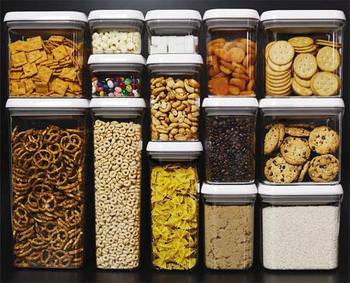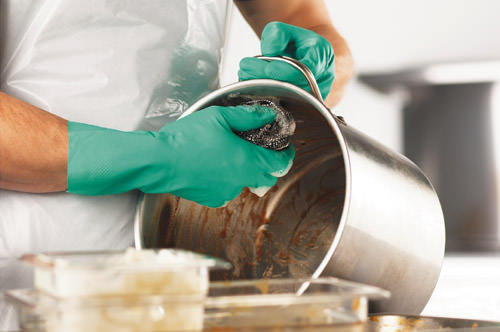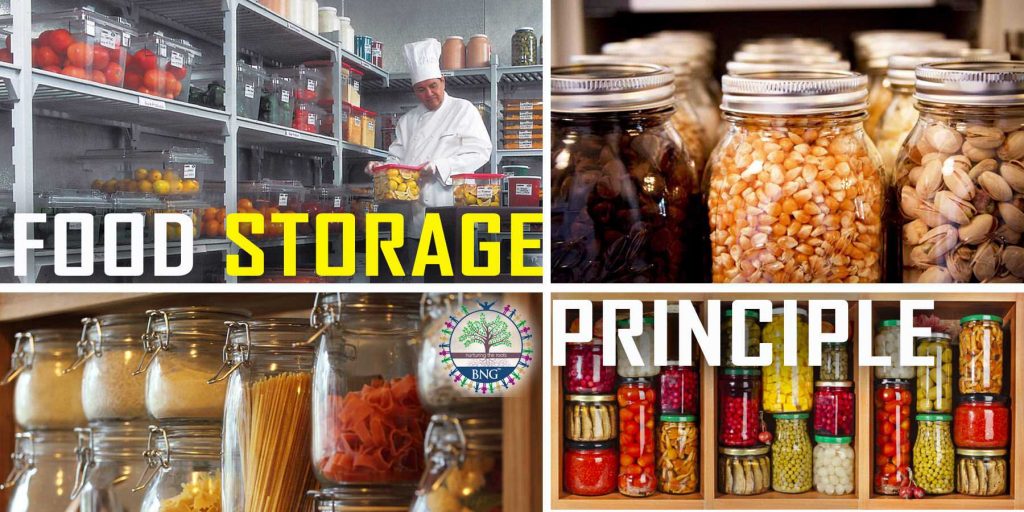Principles of food storage
Here in this article we will discuss about food storage principles and various related topic on dry food, freezer, refrigerator temperature, hot food handling, cleaning and sanitizing, dishwashing, kitchen utensils and equipment, rodent and insect control, temperature and humidity.
FOOD STORAGE
The following rules of food storage have two purposes:

To prevent contamination of foods.
To prevent growth of bacteria that may already be in foods.
Temperature control is an important part of food storage. Perishable foods must be kept out of the Food Danger Zone – 45oF to 140oF (7oC to 60oC) – as much as possible, because these temperatures support bacterial growth.
Dry Food Storage
Dry food storage pertains to those foods not likely to support bacterial growth in their normal state. These food include
- Flour
- Sugar and Salt
- Cereals, Rice and Other Grains
- Dried Beans and Peas
- Ready-Prepared Cereals
- Breads and Crackers
- Oils and Shortenings
- Canned and bottled foods (unopened)
- Store dry foods in a cool, dry place, off the floor, away from the wall, and not under a sewer line.
- Keep all containers tightly closed to protect from insects, rodents, and dust. Dry foods can be contaminated, even if they don’t need refrigeration.
Read more on Food Storage & 7 Golden Rules ..here
Freezer and Food Storage
- Keep frozen foods at 0oF (-18oC) or lower.
- Keep all frozen foods tightly wrapped or packaged to prevent freezer burn.
- Label and date all items.
- Thaw frozen foods properly. These methods may be used:
- In refrigerator.
- Under cold running water.
- In microwave oven, if the item is to be cooked or served immediately.
Do not thaw at room temperature because the surface temperature will go above 45oF (7oC) before the inside is thawed, resulting in bacterial growth.
Refrigerator Temperature
- Keep all perishable foods below 45oF (7oC).
- Do not overcrowd refrigerators. Leave space between items so that cold air can circulate.
- Keep refrigerator doors shut except when removing or putting in foods.
- Keep shelves and interiors of refrigerators clean.
- Store raw and cooked items separately if possible.
- If raw and cooked foods must be kept in the same refrigerator, keep cooked foods above raw foods. If cooked foods are kept below raw foods, they can become contaminated by drips and spills. Then, if they are not to be cooked again before serving, they can be hazardous.
- Keep refrigerator foods wrapped or covered and in sanitary containers.
- Do not let any unsanitary surface, such as the bottoms of other containers touch any food.
- Chill foods as quickly as possible over ice or in a cold water bath before placing in refrigerator. A gallon of stock placed in a refrigerator hot off the stove may take 10 hours to go below 45oF, giving bacteria plenty of time to grow.
- When holding foods such as protein salads in a cold bain marie or refrigerated table for service, do not heap the food above the level of the container. The food above this level will not stay cold enough.
Hot Food Handling
- To keep foods hot for service, use steam tables or other equipment that will keep all parts above 140oF (60oC) at all times.
- Keep foods covered.
- Bring foods to holding temperature as quickly as possible by using ovens, steamers, range-top pots and pans, or other cooking equipment. Do not warm up cold foods by placing them directly in the steam table. They will take too long to heat and bacteria will have time to grow.
- Do not let ready-to-eat foods come in contact with any contaminated surface.
FOOD HANDLING AND PREPARATION
We face two major sanitation problems when handling and preparing food. The first is cross-contamination, which is the transfer of bacteria to food from another food or from equipment or work surfaces.
The second problem is that, while we are working on it, food is usually at a temperature between 45oF and 140oF, or the Food Danger Zone. The lag phase of bacteria growth helps us a little, but to be safe we must keep foods out of the danger zone whenever possible.
- Start with clean, wholesome foods from reputable purveyors. Whenever applicable, buy government-inspected meats, poultry, fish, dairy, and egg products.
- Handle foods as little as possible. Use tongs, spatulas, or other utensils instead of hands when practicable.
- Use clean, sanitized equipment and worktables.
- Clean and sanitize cutting surfaces and equipments after handling raw poultry, meat, fish, or eggs and before working on another food.
- Clean as you go. Don’t wait until the end of the workday.
- Wash raw fruits and vegetables thoroughly.
- When bringing foods out of the refrigeration, do not bring out more than you can process in an hour.
- Keep foods covered whenever possible unless in immediate use.
- Do not let any perishable foods remain in the temperature danger zone for more than 1 hour.
- Boil leftover gravies, sauces, soups, and vegetables before serving.
- Don’t mix leftovers with freshly prepared foods.
- Chill all ingredients for protein salads and potato salads before combining.
- Chill custards, cream fillings, and other hazardous foods as quickly as possible by pouring them into shallow, sanitized pans, covering them, and refrigerating. Do not stack the pans.
- Cook all pork products to an internal temperature of at least 150oF (65oC).
CLEANING AND SANITIZING EQUIPMENT
Cleaning means removing visible soil. Sanitizing means killing disease-causing bacteria are by heat and by chemicals.
Manual Dishwashing
Figure below shows the setup of a three-compartment sink for washing dishes, glassware, and eating utensils by hand.
Procedure
- Scrape and pre-rinse – The purpose of this setup is to keep the wash water cleaner longer.

- Wash – Use warm water at 110oF to 120oF (43oC to 49oC) and a good detergent. Scrub well with a brush to remove all traces of soil and grease.
- Rinse – Use clean, warm water to rinse off detergent. Change the water frequently, or use running water with an overflow, as shown in the figure.
- Sanitize – Place utensils in a rack and immerse in hot water at 170oF (77oC) for 30 seconds. (A gas or electric heating element is needed to hold water at this temperature.)
- Drain and air-dry – Do not towel dry. This may re-contaminate utensils. Do not touch food contact surfaces of sanitized dishes, glasses, and silverware.
Mechanical Dishwashing
The steps in washing dishes by machine are the same as in the hand method, except that the machine does the washing, rinsing, and sanitizing.
Procedure
- Scrape and pre-rinse.
- Rack dishes so that dishwasher spray will strike all surfaces.
- Run machine for a full cycle.
- Sanitizing temperatures: 180oF (82oC) for machines that sanitize by heat. 140oF (60oC) for machines that sanitize by chemical disinfectant.
- Air-dry and inspect dishes. Do not touch food contact surfaces.
Washing Kitchen Utensils and Equipment
- Use the same three-compartment sink setup and procedure as for manual dishwashing.
- Do not use scouring powder or steel wool. These may make scratches where bacteria can hide. Also, pieces of steel wool break off and can remain in the pan and thus get into food.
- Utensils with baked-on foods should be scraped and pre-rinsed, soaked in the first compartment to loosen the baked-on food, then scraped and pre-rinsed again.
- Sanitizing of kitchen equipment may be done with chemical disinfectants instead of heat. Use an approved disinfectant, and follow the instruction on the label.
Cleaning and Sanitizing Stationary Equipment and Work Surfaces
- Unplug electric equipment before cleaning. You could seriously injure yourself if you accidentally hit the power switch while you are cleaning a piece of equipment.
- Dissemble equipment when possible. (This obviously doesn’t apply to such equipment as worktables.) All immersible parts should be cleaned and sanitized like kitchen utensils.
- Wash all food contact surfaces, using a detergent solution and clean cloths.
- Sanitize all surfaces with a double-strength sanitizing solution and with clean cloths used only for this purpose.
- Allow to air dry.
- Reassemble equipment.
RODENT AND INSECT CONTROL
Rats, mice, flies, and cockroaches can spread disease by contaminating food and food contact surfaces. Any sign of rodent or insect infestation is usually considered a serious violation of health codes.
There are four basic methods of pest control. We start with the most important and most effective.
Build Them Out
- Block all possible rodent entrances, including structural defects in the building.
- Put screens on all windows and doors.
- Make sure all doors are self-closing, or install fly fans or air curtains.
- Inspect incoming supplies for sign of insect infestation.
Eliminate Harborage and Breeding Places
- Repair holes in walls or floors, or any other structural defects.
- Eliminate narrow spaces between and behind equipment, counters, or other fixtures, and hollow spaces made by false bottoms in counters, cabinets, etc.
- Store food and supplies off the floor.
- Seal all cracks and crevices. Repair loose tiles, wall coverings, and so on.
- Remove all fly-breeding places inside and out: garbage, manure, and general filth.
Eliminate Food Supplies
- Keep all foods tightly covered or wrapped.
- Keep garbage containers tightly covered, and use metal (rat-proof) garbage cans.
- Clean up all spilled food.
- General sanitation: keep floors, walls, and equipment clean.
Exterminate
Hire a qualified, licensed exterminator, who knows how to use poisons, insecticides, and traps. Most poisons should not be used in s food production operation, so it’s better not to do the job yourself.
Extermination is only a temporary solution. For permanent freedom from rodents and insects, you must rely on the other methods of control.
Here learn The Ten Principles of Correct food Storage ..
FOOD STORAGE
To ensure that foods do not become hazardous to health while in storage three important aspects need to be considered:
- Temperature prevailing in storage’s
- Humidity in the food storage environment
- Presence or absence of any type of infestation
TEMPERATURE
Food Storage temperatures will depend on the type of foods to be held and the period for which they have to be stored.
In general most bacteria are inactivated fat freezing point i.e 0°C and below. Between 1.7°C and 4.4°C they start becoming active but grow slowly. As the temperature rises the activity increases becoming optimum at 37°C which is the normal body temperature.
Recommended food storage temperatures for food materials.
FOODS > TEMP. RANGE > GENERAL REMARKS
- Frozen foods >-10°C to –20°C > maximum temperature
- Fish and sea food > -5°C to –1.1°C > for all perishable foods
- Meat and poultry > 0.6°C to 3.3°C > is between 7.2C to 10C.
- Milk and milk products > 3.3°C to 7.8°C > Bananas are best stored
- Fruits and vegetables > 5.1°C to 7.2°C > at 20C to 25C or normal
- Eggs > 7.2°C to 10°C > room temperature
- General products > 21.1°C
- All dry stores like flour, sugar, condiments > 15°C to 22°C
Most perishables should be kept at temperatures below 10°C, semi or non-perishables at 10°C-20°C to arrest microbial growth.
HUMIDITY
The moisture content of the air around stored foods affects the rate of growth of various organisms. Foods that can be safely stored at higher temperatures are those which have a relatively low moisture content, like flours, sugar, cereals, pulses and legumes. But these foods also the ability to absorb moisture when exposed to it. In humid conditions of food storage and in the presence of air, microbial growth and insect infestation is prevalent. Thus, when food absorbs moisture, it becomes more perishable food and then requires a lower food storage temperature. Therefore, the existing temperatures become relatively too high to protect the foods against microbial attack as the temperature of dry storage’s cannot be change. Humidity also deteriorates the quality of food through insect infestation making it unfit for consumption.
In tropical countries where humidity in the atmosphere changes drastically with the seasons, the best method of protecting dry food, is to store in quantities that are consumed fast enough to prevent deterioration and while in stock, store in air-tight containers.
PRESENCE OR ABSENCE OF INFESTATION
The presence of infestation in or around a store can contaminate food in storage and make it unfit for human consumption, even if hygiene and sanitation is carefully adhered to in the preparation and service of the food. A substantial number of diarrhea cases have been attributed to unsafe food, directly contaminated with microorganisms. Apart from these, infestations due to the presence of insects, fleas, cockroaches, rodents etc. are common. When any of these pests come in contact with food which if consumed could lead to food poisoning. Contamination by pests occurs through the droppings they leave behind. Flies habitually ease themselves on food while feeding, through saliva or dirt collecting on the fine hairs on their body, which may be left in the food. Some may deposit eggs of parasitic worms on food.
Pests find their way into food through defective drains hotels in food packages or bags or doors and waste material storage’s outside or within kitchens. Some pests like cockroaches remain in dark, uncleaned corners, crevices of walls, behind cupboards, under equipment and in drawers, etc. It is also difficult to locate a cockroaches generally do not come out of their hideouts in the daytime. An inspection is therefore necessary at night.





